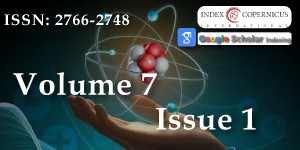Thermoelectric Materials Based on Lead Telluride and Prospects for their Practical Application
Main Article Content
Abstract
Lead telluride (PbTe) is considered one of the most promising materials in thermoelectrics due to its unique thermoelectric properties. This semiconductor exhibits a high thermoelectric figure of merit (ZT) in certain temperature ranges, making it highly effective for converting heat energy into electricity. Additionally, PbTe is characterized by stability and low thermal conductivity, which further enhances the efficiency of thermoelectric devices. Another advantage of using PbTe is its relative affordability and high availability of raw materials. This makes it attractive for manufacturing mass thermoelectric devices such as thermoelectric modules for automobiles, industrial thermoelectric generators, heat recirculation, and others. The paper provides a review of works and an analysis of general approaches to semiconductor thermoelectric materials, including lead telluride.
Article Details
Copyright (c) 2024 Pavlovskyy Y, et al.

This work is licensed under a Creative Commons Attribution 4.0 International License.
The International Journal of Physics Research and Applications is committed in making it easier for people to share and build upon the work of others while maintaining consistency with the rules of copyright. In order to use the Open Access paradigm to the maximum extent in true terms as free of charge online access along with usage right, we grant usage rights through the use of specific Creative Commons license.
License: Copyright © 2017 - 2025 |  Open Access by International Journal of Physics Research and Applications is licensed under a Creative Commons Attribution 4.0 International License. Based on a work at Heighten Science Publications Inc.
Open Access by International Journal of Physics Research and Applications is licensed under a Creative Commons Attribution 4.0 International License. Based on a work at Heighten Science Publications Inc.
With this license, the authors are allowed that after publishing with the journal, they can share their research by posting a free draft copy of their article to any repository or website.
Compliance 'CC BY' license helps in:
| Permission to read and download | ✓ |
| Permission to display in a repository | ✓ |
| Permission to translate | ✓ |
| Commercial uses of manuscript | ✓ |
'CC' stands for Creative Commons license. 'BY' symbolizes that users have provided attribution to the creator that the published manuscripts can be used or shared. This license allows for redistribution, commercial and non-commercial, as long as it is passed along unchanged and in whole, with credit to the author.
Please take in notification that Creative Commons user licenses are non-revocable. We recommend authors to check if their funding body requires a specific license.
d’Angelo M, Galassi C, Lecis N. Thermoelectric Materials and Applications: A Review. Energies. 2023; 16:17; 6409-6459.
Anatychuk LI, Luste OJ, Kuz RV, Strutinsky MN. Inverse problems of Thermoelectricity. Journal of Electronic Materials. 2011; 40;856-861.
Bylina IS. Mechanisms of Structure and Thermoelectric Properties of Vapor-Phase Condensates Solid Solution PbTe-Bi2Te3 on Ceramics. Physics and Chemistry of Solid State. 2015; 16:1; 83-92.
Ahmad S, Mahanti SD, Hoang K, Kanatzidis MG. Ab initio studies of the electronic structure of defects in PbTe. Phys. Rev. B. 2006; 74:15; 155205-155210.
Popescu A, Woods LM. Enhanced thermoelectricity in composites by electronic structure modifications and nanostructuring. Appl. Phys. Lett. 2010; 97:5; 052102-052108.
Kim W, Zide J, Gossard A, Klenov D, Stemmer S, Shakouri A, Majumdar A. Thermal conductivity reduction and thermoelectric figure of merit increase by embedding nanoparticles in crystalline semiconductors. Phys Rev Lett. 2006 Feb 3;96(4):045901. doi: 10.1103/PhysRevLett.96.045901. Epub 2006 Feb 2. PMID: 16486849.
Niua J, Shen H, Li X, Xu W, Wang H, Li LS. Controlled synthesis of high-quality PbSe and PbTe nanocrystals with the one-pot method and their self-assemblies. Colloids and Surfaces A: Physicochemical and Engineering Aspects. 2012; 406:38-43.
Gao X, Daw MS. Investigation of band inversion in (Pb, Sn) Te alloys using ab initio calculations. Physical Review: B. 2008; 77:3; 033103-03318.
Hummer K, Gruneis A, Kresse G. Structural and electronic properties of lead chalcogenides from first principles. Physical Review: B. 2007; 75:19;195211-195218.
Levytskyi SN, Boyko MI, Vlasenco OI, Kryskov TA. Improvement of Technologies of Synthesis of AIVBVI Semiconductors and Solid Solution on Their Basis. Physics and Chemistry of Solid State. 2011; 12:4;1039-1041.

